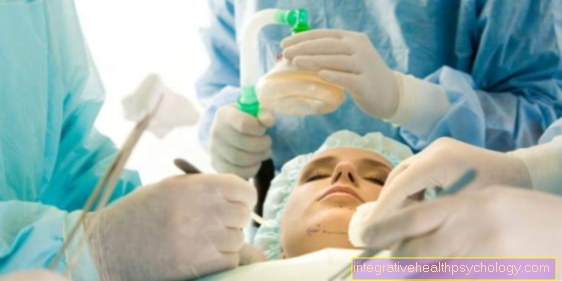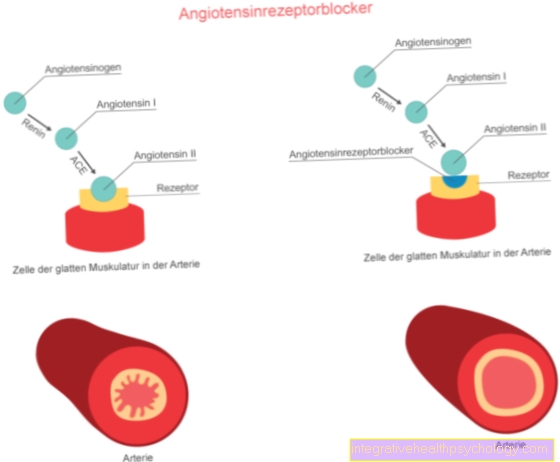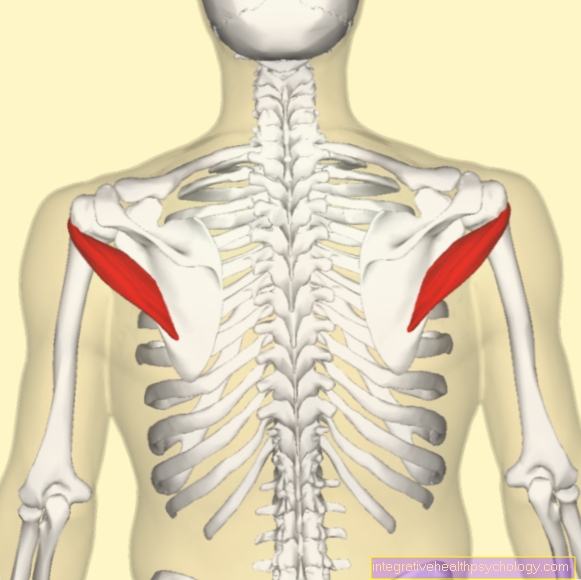Risks of anesthesia
introduction
As with any human intervention, anesthesia also has a certain risk, which must be recognized and kept as low as possible.
The risks of anesthesia depend on many different factors. On the one hand, the risk depends on the planned surgical procedure and the duration and type of anesthesia. On the other hand, the patient's constitution and previous illnesses play an essential role.
Therefore, before each anesthesia, the individual risk of the patient is assessed in a conversation with an anesthetist and appropriate measures are taken to minimize the risk as best as possible.

Overview of the risks of anesthesia
The risks of anesthesia depend heavily on the anesthetic method chosen, the duration of the anesthesia and the materials used. With general anesthesia, a ventilation tube is usually inserted into the windpipe. This is necessary because the anesthetic medication prevents the patient from breathing. However, the ventilation tube irritates the mucous membrane, which can damage the vocal cords or the teeth.
In rare cases, incorrect intubation into the esophagus occurs. The ventilation tube can then damage the lining of the esophagus. The anesthetic drugs also inhibit all protective reflexes of humans. During anesthesia, this can lead to stomach contents reaching the lungs (aspiration). This can then become inflamed in the lungs and cause pneumonia.
Furthermore, the risks of anesthesia depend very much on the patient's underlying illnesses. For example, people with diabetes mellitus or diseases of the cardiovascular system have a significantly higher risk of anesthesia than healthy people.
Another risk, which particularly affects women and young patients, is postoperative nausea, which is also associated with vomiting (PONV).
The risks of anesthesia are largely determined by the patient himself and by the upcoming procedure.
Read more on the subject at: Types of anesthesia - which are there?
Complications during anesthesia
If complications occur during anesthesia, this can be recognized relatively quickly based on the circulatory values such as blood pressure, pulse, oxygen saturation and body temperature. These are therefore constantly observed and noted by the anesthetist in order to have a progress. Muscle activity can also occur if the anesthesia is too weak.
Causes of the risks of anesthesia
Reasons for the risks of anesthesia can, for example, be a poor general condition of a patient due to a serious illness or an unknown intolerance to certain anesthetics.
Problems intubating
Teeth are an important issue when it comes to the risks of anesthesia. Since the airways are mainly reached via the oral cavity in order to secure the airways for an anesthesia, the necessary instruments, such as an intubation spatula and intubation tube, must therefore also be used close to the teeth. Now you have to note that the anesthetics relax the muscles, so that the jaw has to be pressed apart with two fingers in order to achieve a sufficient opening of the mouth.
It should also be noted that the spatula is made of a hard material, usually steel. In order to push the tongue, which is also slack, out of the way with the spatula and then to get to the epiglottis, a certain sequence of movements is carried out in which the spatula is not levered if possible. The consequence would be that the movement with the spatula would damage the incisors in the worst case.
The anesthetists are very experienced with intubation, but it can happen again and again that the teeth are touched, for example in a life-threatening situation or in the event of a misalignment of the oral and maxillofacial apparatus. There are mouthguards, but they usually hinder the intubation process more than they use.
Read more on the topic: Intubation anesthesia
Which form of anesthesia has the highest risk of anesthesia?
The anesthetic procedures and patient monitoring have become more and more secure in recent years, which is why the risk no longer depends so much on the type of anesthesia, but much more on the patient's constitution and previous illnesses.
If one nevertheless compares the various forms of anesthesia, one can say that the so-called rapid sequence induction or crash initiation has the highest risk.This form of anesthesia is used for patients who are not fasted and who still need an urgent intubation to prevent stomach contents from getting into the lungs. Patients with no food for less than 6 hours, but also pregnant women and overweight people, are considered to be not fasting. Since induction of anesthesia with this procedure has a different process than standard general anesthesia, there are increased risks here.
Read more on the topic: Side effects of anesthesia
Risks of anesthesia in different age groups
Risks of anesthesia in the elderly
With increasing age, the risks of anesthesia and surgery also increase.
The risks of anesthesia in old age are mainly characterized by the numerous comorbidities of the respective patient. The focus is on diabetes mellitus, high blood pressure, pronounced cardiac insufficiency, lung disease, as well as decreased function of the liver and kidneys.
This can mean that certain anesthetics may not be given at all and you have to switch to alternatives.
Post-operative delirium is an anesthetic-specific problem after an operation. Patients over 60 are particularly affected and then appear confused and disoriented, the sleep-wake cycle and memory can also be affected.
To prevent this, regional anesthesia procedures can be used instead of general anesthesia, these do not work in the brain and therefore have a lower risk of such side effects.
Other common complications in the elderly after surgery are wound healing disorders, thromboses, embolisms and infections.
Because of these risks, both the preparation for the operation and the follow-up care and monitoring are more intensive in the elderly than in young, healthy patients.
Find out all about the topic here: Postoperative delirium
Risks of anesthesia in infants
Risks of anesthesia in an infant primarily concern securing the airways. On the one hand, work should be done quickly here, since infants have a smaller reserve of oxygen and “desaturate” more quickly. On the other hand, this work step is made more difficult by the small, narrow airways.
If you induce an infant with inhaled anesthetics, you should counteract a possible breakdown of the circulatory system due to the high sensitivity due to the rapid increase in concentration. In addition to securing the airway, maintaining and supplying warmth is essential for the infant, as hypothermia can quickly develop. Another risk is the tolerability and correct dosage of the anesthetic, which, however, is individually adapted and carried out for the patient by trained staff.
Depending on the surgical procedure, there can be an additional risk of anesthesia. Since anesthesia is indispensable for certain interventions in an infant, its benefit should not be neglected. Since the individual risks of an infant can also arise, it is best to address further questions to the anesthetist, with detailed information from a doctor taking place before each procedure.
Risks of anesthesia in young children
First of all, it should be made clear that a toddler cannot be compared to a small adult, so that not all risks of anesthesia in an adult can be transferred one-to-one to a toddler.
On the one hand, the organs of a toddler are not yet fully developed, which is important to know when administering medication. On the other hand, the metabolic status of a toddler must be taken into account. Malformations of the mouth and jaw system, for example in Pierre Robin Syndrome or an enlarged tongue in Down syndrome, can already cause difficulties with ventilation and intubation. In addition, a recent respiratory infection can pose a risk of anesthesia in young children, as the bronchi can become more irritated and cramp, making ventilation difficult.
In addition, the high demand for heat during anesthesia must be taken into account and covered in order to avoid associated complications. The consumption of fluids and nutrients must also be individually controlled and administered in order to avoid hypoglycaemia or dehydration. The supply of oxygen is even more important than in adults. The time between oxygenation of the blood and connection of the ventilator should therefore be kept very short, as a toddler desaturates much more quickly than an adult.
In addition, there are the risks of the surgical intervention itself, which can also affect the course of the anesthesia. Of course, the anesthetists know about the special risks of anesthesia and can prepare accordingly before an operation, so that the risks are generally kept relatively low. In addition, a detailed discussion with an anesthetist takes place in advance to explain the risks of anesthesia, and there is always time for questions.
Read more on the topic: Anesthesia in children
Risks in overweight patients and smokers
Risks of being overweight
Overweight patients are considered to be at risk, and this is especially true if they are very overweight. The additional body mass can lead to numerous complications before, during and after the anesthesia.
Overweight patients often suffer from comorbidities such as Diabetes and high blood pressure. In addition, there are often problems with cardiac output and breathing, which increase the risk of anesthesia and surgery.
The introduction of the tube into the trachea before the operation can be made significantly more difficult by the mass of fat. These can obstruct the airways and thus increase the risk of incorrect intubation, in which case the tube is accidentally inserted into the esophagus instead of the trachea. To prevent this, fiberoptic instruments with cameras are often used in difficult intubations.
Read more about the topic here: Intubation
Another problem can be the correct dosage of the medication required for anesthesia, as overweight people need a higher dose to achieve the desired effect.
The patient must also be closely monitored after the operation, because overweight people have an increased risk of thrombosis and the resulting embolism, which, for example, can be life-threatening in the case of pulmonary embolism.
Risks of anesthesia in smokers
Smoking has numerous negative effects on the body and therefore also carries an increased risk of anesthetic complications. On the one hand, smoking can reduce the function of the heart, blood vessels and lungs, which increases the general risk of surgery.
Smoking also stimulates the production of gastric juice. In spite of the alleged sobriety of the patient, a lack of food and fluids can lead to a large accumulation of stomach contents, which increases the risk of vomiting and subsequent penetration of gastric juice into the airways (aspiration). Not only is there a risk of suffocation, the acidic gastric juice can also damage the lung tissue.
In addition, a study has shown that smokers, compared to non-smokers, need a higher dose of anesthetics and painkillers to achieve the desired effect.
For the anesthetic propofol, a 38% higher dose had to be used to induce anesthesia and a 33% higher dose to maintain anesthesia. The reason for this is still unclear, but the effect of nicotine is suspected. Smokers also have a higher risk of wound healing disorders and thrombosis after surgery.
Risks of anesthesia during surgery
The risks of anesthesia during an operation always depend on the risk profile of the patient and on the operation itself. If an emergency operation is carried out without time for adequate preparation, the risk of complications increases sharply. An example is the flow of chyme into the windpipe in a patient who is not fasted. Here, however, a stomach tube is usually placed in advance to collect the stomach contents.
If the patient is particularly ill, the condition can quickly worsen during an operation due to the stress that affects the organism. This can also be indicated relatively quickly by the circulatory parameters, which the anesthetist continuously monitors during an operation. Since there are also respective standards for every OP, which define the process and the necessary equipment, compliance with the anesthesia and the OP provides additional security and minimizes the risks.
Risks of anesthesia during a gastroscopy
In the case of a gastroscopy, local anesthesia of the throat and, if necessary, a short anesthesia are usually used to calm the patient down. Since this is not a general anesthetic, there is usually no need for ventilation.
One of the risks of anesthesia is an intolerance to the anesthetic agent. During the gastroscopy, there is a risk that the anesthetic will become ineffective more quickly than expected and that an additional dose has to be given so that the patient sleeps deeply enough. After the procedure, you may not feel completely fit, so it would be good if you had someone to look after you.
The ability to drive can also be impaired, so driving a car or the like should be avoided. Otherwise a gastroscopy with anesthesia is considered to be relatively low-risk.
Read more on the topic: Anesthesia during a gastroscopy
Therapy to manage the risks of anesthesia
The therapy to manage the risks of anesthesia depends on the cause. It is certainly advantageous to address treatable risks in advance, for example by setting the high blood pressure or by performing a nerve block beforehand in order to save the administration of painkillers during anesthesia.
Diagnosis for risks of anesthesia
The diagnosis of the risk of anesthesia can be clarified before the anesthesia by asking about risk factors that have to be taken into account. During anesthesia, the values of the circulatory system, which are constantly displayed on the monitor, help to identify risks of anesthesia at an early stage.
Prognosis after anesthesia
Thanks to the steady progress in the field of anesthesia in recent years, the risks of anesthesia have already been greatly reduced. Further improvements in anesthesia are also in sight for the future.
Prophylaxis of the risks of anesthesia
To prevent the risk of anesthesia, a well-functioning organization is very important for a smooth process. The team of doctors and nurses should be well coordinated. In addition, standardized questionnaires for clarification and anamnesis ensure that an accurate picture of the risk profile of the respective patient is obtained.
All documents are collected in a file and checked several times before an operation. Particular attention is paid to avoidable complications, such as allergies to certain drugs or relevant congenital malformations.





























